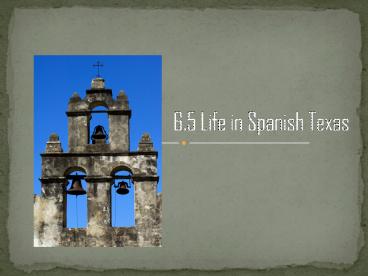6.5 Life in Spanish Texas - PowerPoint PPT Presentation
1 / 17
Title:
6.5 Life in Spanish Texas
Description:
The Spanish wanted Texas Indians to live in the missions and learn the Spanish way of life. In the missions, life followed a daily pattern of worship and work. – PowerPoint PPT presentation
Number of Views:446
Avg rating:3.0/5.0
Title: 6.5 Life in Spanish Texas
1
6.5 Life in Spanish Texas
2
Life in the Missions
- The Spanish wanted Texas Indians to live in the
missions and learn the Spanish way of life. - In the missions, life followed a daily pattern of
worship and work. - The day started at dawn with religious services.
For at least and hour, priests taught mission
Indians about the Catholic faith.
3
Life in the Missions
- American Indian men tended crops of beans, corn
and cotton. - The women made pottery, cared for livestock, wove
cloth and ran the mission kitchen. - The day ended with prayers and dinner usually a
thin cereal.
4
Life in the Missions
- When they were not in church or working, mission
Indians also learned Spanish songs and dances. - The Spanish hoped these lessons would encourage
Indians to abandon their traditional
celebrations. - This strategies rarely worked as Indians left the
mission during hunting or fishing seasons.
5
Life in the Missions
- Mission inhabitants would eat mesquite beans when
food was scarce.
- Mission life was also harsh.
- Typically the dwellings were uncomfortable, with
dirt floors and open windows. - People living in missions sometimes went hungry.
In the East Texas missions food was often
scarce. - The Indians sometimes helped in needy times.
6
Life in the Missions
- Conditions were better at other missions,
particularly San Antonio and El Paso. - By 1750, one mission had 2,000 cattle and 1,000
sheep - Mission Indians there harvested 2,400 bushels of
corn. - By 1780, Indians were irrigating the missions
crops.
7
Life in the Missions
- Missions in present day San Antonio and El Paso
thrived because Indians there adopted Spanish
cultures. - Other missions such as those in East Texas and La
Bahia, helped Spain gain a presence in the
borderlands.
8
Life in the Presidios
- Presidio La Bahia
- Missions were more likely to succeed if they had
a presidio nearby. - These military outposts were made of adobe, stone
and timber. - Presidios had a chapel, barracks for soldiers,
storage rooms and a headquarters building.
Sometimes a stockade, or wall surrounded these
buildings.
9
Life in the Presidios
- Soldiers in the presidios had several duties.
They guarded the mission and helped supervise the
mission Indians who lived there. - Missionaries and soldiers often disagreed on how
to treat the Indians and who had the higher
authority in the borderlands. - The tension added to the hardship of living in
the small isolated presidios
10
Life in the Presidios
- Although their work was risky, the soldiers
received low wages. - Many soldiers fell into debt because their pay
was late in coming. - In addition, the soldiers had poor equipment and
their uniforms were worn and ragged. - Despite the harsh conditions, some soldiers
brought their families with them. - Eventually, a few of these families left the
presidios and helped start Spanish settlements.
11
Life in the Settlements
- Texas settlements had diverse populations of
Spaniards, American Indians, and African
Americans. - Most of the Spanish had moved north from Mexico
in search of good land for farming or ranching. - Some settlers were former soldiers who married
Texas Indians. - Although few free African Americans lived in the
settlements, most were brought as slaves.
12
Life in the Settlements
- A few permanent Texas towns grew from the mission
system. - These towns were scattered over a huge area.
- As they grew, these Spanish settlements shared
some similarities with modern towns - Many had well defined streets and government
buildings. They also had stores including
bakeries and candle shops.
13
Life in the Settlements
- In San Antonio, by far the largest settlement,
dams were built to create an irrigation system of
canals. - San Antonio was the first town that allowed
people to participate in government. - When the Canary Islanders first came, they were
given lands and a charter for their settlement,
San Fernando de Bexar.
14
Life in the Settlements
- Spanish Coat of Arms
- The ayuntamiento, or governing council, enforced
royal and local laws. - The alcalde, served as mayor, sheriff and judge
of small cases. - The viceroy in Mexico City had authority over all
settlements in New Spain, including Texas. - The governor represented the viceroy in Texas.
15
Life in the Settlements
- The economy of the settlements was mostly based
on farming and ranching. - The cattle business helped San Antonio and other
towns grow. - Most social activities centered around the family
and the church. - Religious holidays offered opportunities for
worship and socializing. - On other special occasions, residence gathered at
fandagos, or dances.
16
Life in the Settlements
- The Spanish greatly influenced the culture and
history of Texas. - Some missions are still active churches.
- The Spanish also laid out the first Texas roads
such as the El Camino Real. - Many place names of cities and natural features
such as rivers are in Spanish
17
Life in the Settlements
- Early Spanish laws protected the property rights
of women. - Women continued to benefit from these laws when
Texas became part of the United States. - Spanish architecture, art, food, language, and
music are alive in Texas today.































